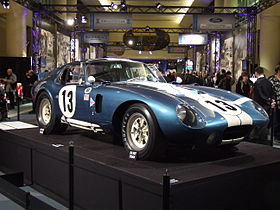| Shelby Daytona | |
|---|---|
 | |
| Overview | |
| Manufacturer | Shelby American |
| Model years | 1964–1965 |
| Assembly | Venice, California, USA Modena, Italy |
| Designer | Pete Brock |
| Body and chassis | |
| Body style | 2-door coupe |
| Layout | FMR layout |
| Powertrain | |
| Engine | Ford 289 cu in (4.7 L) V8 |
| Dimensions | |
| Wheelbase | 2,286 mm (90 in)[1] |
| Length | 4,150 mm (163.4 in) |
| Width | 1,720 mm (67.7 in) |
| Height | 1,180 mm (46.5 in) |
| Curb weight | 1,043 kg (2,299 lb) |
The Shelby Daytona Coupe (also referred to as the Shelby Daytona Cobra Coupe, incorrectly) is an American sports-coupé. It is related to the Shelby Cobra roadster, loosely based on its chassis and drive-train developed and built as an advanced evolution. It was engineered and purpose built for auto racing, specifically to take on Ferrari and its 250 GTO in the GT class. The original project had six Shelby Daytona Coupes built for racing purposes between 1964 and 1965, as Carroll Shelby was reassigned to the Ford GT40 project to compete at the 24 Hours of Le Mans, again to beat Ferrari in the highest level prototype class.
Shelby won a title in the International Championship for GT Manufacturers in the 1965 season with the Shelby Daytona car, thus becoming the first American constructor to win a title on the international scene at the FIA World Championships. In 2014, the first Cobra Daytona Coupe became the first vehicle recorded under a U.S. federal program for documenting historically important national treasures.[2]
- ^ Melissen, Wouter (September 21, 2015). "Ultimate Car Page". Ultimatecarpage.com. Retrieved February 2, 2013.
- ^ Markus, Frank (January 27, 2014). "1964 Shelby Daytona Coupe: First Car in National Historic Vehicle Register". Motor Trend. Retrieved March 26, 2023.